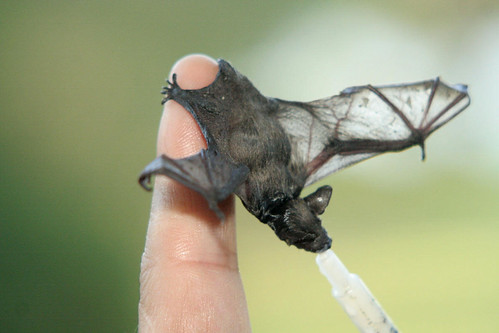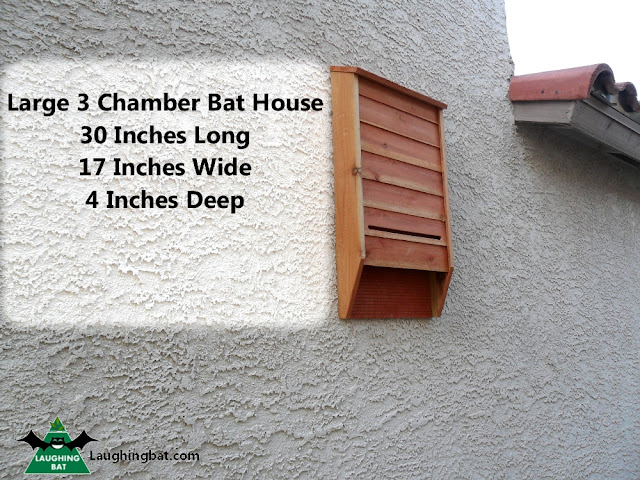Saving the Planet...One Bat House At a Time!
Tuesday, October 19, 2010
New Large Three Chamber Bat House
Saturday, September 4, 2010
Laughing Bat Success Featured on Information Farm:
 |
| Laughing Bat's marvelous creators! |
Tuesday, August 31, 2010
A CALL TO ACTION! White-Nose Syndrome & What We Can Do To Help!
that are unprecedented in the history of wildlife studies in North America
and in the world, for that matter.”
 |
| White-Nose Syndrome |
 When I first heard about White-Nose Syndrome I was struck with disbelief. This bat-killing fungus was unknown before 2006. In 2009 and 2010, investigations of some New York State caves found up to 100% of the bat population had died! Especially hard hit has been the Little Brown Bat (Myotis lucifugus). This bat species has survived for 52 million years.
When I first heard about White-Nose Syndrome I was struck with disbelief. This bat-killing fungus was unknown before 2006. In 2009 and 2010, investigations of some New York State caves found up to 100% of the bat population had died! Especially hard hit has been the Little Brown Bat (Myotis lucifugus). This bat species has survived for 52 million years. 52 MILLION YEARS this species has survived and adapted to many of this worlds most extreme changes and now faces extinction in only a matter of years if The White-Nose Syndrome fungus is not stopped.
 |
| Bat eating a bug! |
 |
| Be Super Heroes! HELP SAVE the bat population! |
Monday, August 23, 2010
Laughing Bat 2.0
Monday, August 2, 2010
SIMPLE STEPS TO A SUCCESSFUL BAT HOUSE
Here is the simplified version of the literature we include with our bat homes, nice and simple...
Follow these simple steps to a successful bat house:
STOP USING PESTICIDES AND OTHER INSECT REPELLENTS. -You want your yard to be a free bat buffet! Bats will move in quickly when they know they will always have a good meal waiting in your back yard.
MOUNT YOUR BAT HOUSE FOLLOWING THE GUIDELINES COVERED IN OUR MANUAL. -Southern exposure, average of 8 hours of sun, match your bat house color to your climate, mount on pole or side of house and at least 12 feet above the ground.
USE OUR INSECT ATTRACTING TIPS EXTERIOR LIGHTS, LURES AND NIGHT BLOOMING PLANTS AND FLOWERS. - There is a natural way to attract the right bugs that will in turn attract the right bats. I cover this in detail in my book, The Law of Bat Attraction.
IF YOU DO NOT HAVE A FRESH WATER SOURCE CLOSE BY, CREATE ONE: A FRESH WATER POND OR BIRD BATH. - Bats have been known to even drink out of swimming pools.
KEEP DOGS AND CATS AWAY FROM BAT HOUSE. - Cats will hunt bats and dogs will bark at anything that moves. I know its not rocket science but keep your pets away from side of your yard where the bat house is mounted.
BE PATIENT. - Bats are very smart. They will not move into a newly mounted structure. They first want to make sure its something that will be premanent, so when you mount your bat house, expect to wait a few months before you see occupants. On the bright side, your bats will stay, hybernate or migrate (depending on your climate) for many years.
CHECK YOUR BAT HOUSE ONCE A MONTH FOR WASPS OR OTHER UNWANTED OCCUPANTS. - Light maintenance is required.
IF THE HOUSE IS NOT OCCUPIED WITHIN THE FIRST YEAR, MOVE IT TO A BETTER LOCATION WITH MORE SUN EXPOSURE. - I say "better location", in my bat manual I go into many details and elaborate on this term. Basically it all comes down to temperature. Your bat house may be too cold. Look into moving it to a place that gets more sun or painting it a darker color. Most bat species like it to be around 100F in their house!
Monday, July 5, 2010
BUSTING BAT MYTHS!
 Bats are misunderstood creatures that are generally quite harmless to people. They do not become tangled in hair, nor do they attack humans. There have been fewer than 10 cases of human rabies infection from bats in the last 50 years!
Bats are misunderstood creatures that are generally quite harmless to people. They do not become tangled in hair, nor do they attack humans. There have been fewer than 10 cases of human rabies infection from bats in the last 50 years!Not many people know, care, or even appreciate bats for their many benefits. Unfortunately, most people believe the myths. When people think about bats, their minds conjure up images of a black silhouette gliding in front of a full moon on Halloween. Many people
 view bats as evil creatures that hang out with witches and vampires. The truth is bats are shy, gentle and intelligent creatures. Don't be afraid if a bat swoops down close to your head. It is not "attacking" you. It is probably catching a juicy mosquito that was about to bite you!
view bats as evil creatures that hang out with witches and vampires. The truth is bats are shy, gentle and intelligent creatures. Don't be afraid if a bat swoops down close to your head. It is not "attacking" you. It is probably catching a juicy mosquito that was about to bite you!In Asia these gentle animals are symbols of good luck, long life and happiness. They are extremely clean animals, meticulous in their grooming, spending a fair part of the day and night combing and grooming their fur.
The old belief that bats are blind was started long ago when we knew little about their sophisticated gift of navigation. When bats fly, they navigate by means of a complex echolocation system. The bat sends out signals of sound waves, which are reflected back, giving the bat the location of an object as well as its texture and other characteristics. They can avoid a single human hair with extreme accuracy, even in total darkness. It is similar to how a submarine navigates using sonar and yet far more accurate and complex.

The Pallid bat (seen above & Below) - Antrozous pallidus - (I gave them the pet name "Pally") is my personal favorite bat because Pally the Pallid bat hunts scorpions!

Pally can hear the foot steps of an insect on the ground from 16 feet away! They fly, navigate and hunt with extreme accuracy. In fact all bats are extremely cool in one way or another. All species of bats are intelligent, clean, sophisticated and very misunderstood. When researching individual species of bats you will come across a common theme among them.
 "We still know very little about this bat." Scientists will admit we have much more to learn about these sophisticated and mysterious mammals, however every year we seem to discover something new and profound.
"We still know very little about this bat." Scientists will admit we have much more to learn about these sophisticated and mysterious mammals, however every year we seem to discover something new and profound.Recently the saliva from the South American species of bat, commonly known as Vampire Bats, has aided in the creation of a new and successful treatment for stroke patients! Even new antibiotics and other medicine have been created from the help of bats. I know in previous blogs I have beaten to death the important rolls bats play in our lives and ecosystems.
What I want is to bust the old bat myths that have plagued these mammals with human fear and persecution! Don't think of them as little blood sucking vampires! They are more like little flying
 kittens! Since they don't attack humans and up close they are gentle, furry and so freaking cute!
kittens! Since they don't attack humans and up close they are gentle, furry and so freaking cute!When you can let go of your unwarranted fear of bats and embrace their grace, let them into your environment, you will reap the great benefits of powerful pest control, pollination and potent fertilizer!
Give a bat a home! Visit our website, Laughingbat.com
btw, Bat Hotels make great gifts too!
Tuesday, June 29, 2010
Open Bottom vs. Closed Bottom Bat House
Q: I have been comparing bat houses and I wanted to know if there is a benefit to having a base at the bottom of the house vs not having a base to prevent the possible fall of a baby bat? I know not having a base is an advantage to not have birds nest in the house, but I am concerned about the safety of baby bats?
My response:
 Thank you for the excellent question! Its amazing how bat mothers take care of their young. Bats share MANY of the same behavioral qualities as humans do. Bat mothers will take great care of their young and nurse them for the first two weeks of their life. After that the babies learn to fly and begin to hunt for bugs!
Thank you for the excellent question! Its amazing how bat mothers take care of their young. Bats share MANY of the same behavioral qualities as humans do. Bat mothers will take great care of their young and nurse them for the first two weeks of their life. After that the babies learn to fly and begin to hunt for bugs!Just think of other animals, such as horses or cows, that can walk only moments after being born, or chicks that have to hatch themselves from their eggs. The act of the baby bats holding onto their mothers and holding onto the sides of the bat house strengthens them for their very long (average of 40 years) and happy bat lives!
Within the two weeks that the babies are still growing strong, getting ready to learn to fly, they live inside the chambers of the home, holding onto their mother and the grooved sides of the chambers.
 In nature, bats would live upside down in caves, mines, barns, attics, and some in the bark of trees. Bats have been around since the age of the dinosaur and have developed the amazing ability to live hanging upside down! In nature, these baby bats do not need a safety net. Bats prefer the open bottom bat house as they can easily locate and land on the landing pad that extends below the chambers and the box.
In nature, bats would live upside down in caves, mines, barns, attics, and some in the bark of trees. Bats have been around since the age of the dinosaur and have developed the amazing ability to live hanging upside down! In nature, these baby bats do not need a safety net. Bats prefer the open bottom bat house as they can easily locate and land on the landing pad that extends below the chambers and the box.I think bats are just amazing animals, so much so, that I wrote a little book to help people manifest successful bat homes. I include great literature along with the bat homes I sell. My husband, who is also a huge bat
 enthusiast, has been a professional carpenter for over 20 years. Together we build our bat homes and look to provide the HIGHEST quality bat home for the most affordable price.
enthusiast, has been a professional carpenter for over 20 years. Together we build our bat homes and look to provide the HIGHEST quality bat home for the most affordable price.Closed bottom Bat Houses are more common in Europe, however, they are larger and require regular maintenance. You would have to take a hose and regularly spray the inside of the bat house (while the bats are not currently home) to clean the build up of urine and guano. If you did not clean it regularly, the build up would increase the bat colonies chances of becoming sick or catching parasites.
Studies have shown that once a bat colony has chosen your bat house, they will return year after year. If you have chosen a good bat house they can last longer then 10 years. By using open-bottom designs, even bat houses abandoned by their human owners will remain available to bats for a long time.
Another point I would like to make is that bats are extremely clean animals, they spend most of their waking day time hours grooming themselves and each other. Since a bat house with a closed bottom would not only make it harder for them to land and enter, it would also collect all their guano (bat droppings) as well as their urine. A much healthier design is the free bottom. Most gardeners love collecting the guano for their compost as it makes an excellent fertilizer.










